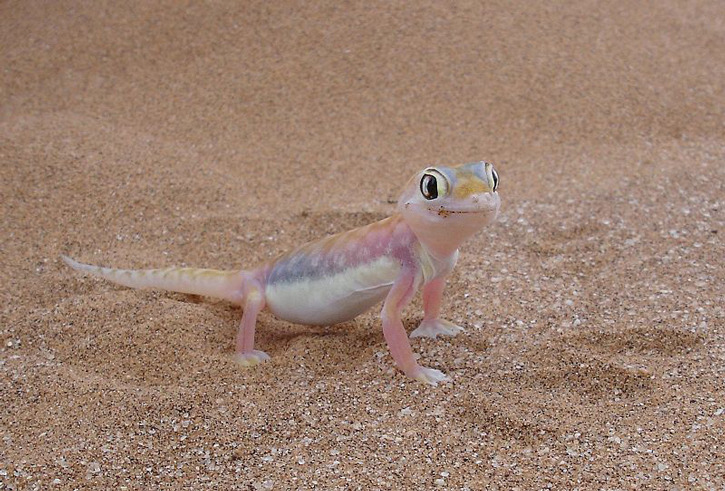10 BEAUTIFUL PINK ANIMALS TO MARVEL AT NOW

Some of the most beautiful animals in the world are pink! We found some strange and exquisite pink creatures to share.

1. ROSEATE SPOONBILL
The Roseate Spoonbill (Platalea ajaja) is not a flamingo, despite how it appears at first blush. They are both wading birds, living in warm climates, and they are a similar shade of pink.
You can find roseate spoonbills sifting through shallow waters with their spoon-shaped bills, catching their dinners along the Gulf Coast of the United States, along the coastlines south to Argentina.
The Roseate Spoonbills’ pink feathers became all the rage in the 19th century for use in ladies’ fans. This fashion statement all but wiped out this beautiful pink species. Now, thanks to conservation efforts, their population is once again on the rise.


2. MAJOR MITCHELL’S COCKATOOS
Check out the pastel pink feathers of the Major Mitchell’s Cockatoo (Lophochroa leadbeateri), offset by deeper coral pink accents, on its crest and wings.
Major Mitchell’s Cockatoos live in light woods and open grasslands in western and central Australia.
The Major Mitchell’s Cockatoo is a social bird, and is usually found in pairs. Sometimes they also hang out with galahs, another indigenous species of pink cockatoo.


3. PINK KATYDID
This bright pink katydid (Amblycorypha oblongifol) always elicits double takes. While their neon pink color has been a subject of debate for the last century, scientists have finally determined that their unusual hue is a genetic mutation, known as erythrism, which produces abnormal redness in an animal’s skin, fur, or plumage.
Pink katydids live, as their green relatives do, in grasslands and forests all across the United States, although predators spot them more easily -- which is why they are much more rare. You can hear them “sing,” as they create trilling sounds by rubbing their wings together.


4. HOPKINS’ ROSE NUDIBRANCH
The Hopkins’ Rose Nudibranch (Okenia rosacea) is a vibrant pink species of sea slug that lives along the Pacific Coast, from Oregon to Baja, California. The name nudibranch comes from the Latin for “naked gills.”
This species gets its pink coloring from a diet of pink bryozoan, tiny colonial marine animals. Their color ranges from pale powder puff blush to intense hot pink -- some evolved as camouflage, and some as warning: Pink - Poison.


5. ELEPHANT HAWK MOTH
The Elephant Hawk Moth (Deilephila elpenor) is incredibly beautiful, with hot pink stripes across its brown wings and body.
Its larvae, aka the Elephant Hawk Caterpillar, has distinctive pink eye spots on its 4th and 5th body segments. When threatened, the caterpillar contracts its head segments and inflate its body segments, making the pink eye spots look larger and more formidable.
This species of moth is only one that hovers over flowers, as hummingbirds do, to sip nectar. It is also one of the fastest flying insects in the world, reaching speeds up to 12 miles per hour.


6. AMAZON RIVER DOLPHIN
Who knew dolphins could be pink?
Say hello to the Amazon River Dolphin (Inia geoffrensis), a pink skinned beauty, native to the freshwater Orinoco, Amazon, and Araguaia/Tocantins River systems of South America.

Also known as the boutu, boto, or bufeo, this pink dolphin is the largest of all freshwater dolphins.
The warm river waters make the dolphins’ capillaries expand, causing them to become visible through their skin, much like when humans blush or flush. Iron content in the water adds to the pink beauty.


7. PINK SQUAT LOBSTER
We love pink Squat Lobsters (Lauriea siagiani)! They aren’t really lobsters, but rather they are a group of 900 species of crabs in the Anomura Order. And the pink ones are totally cool.
The Pink Hairy Squat Lobster is one of our faves. It is sometimes called a Fairy Crab for its delicate fanciful appearance. While it is tiny -- only ½” long -- it packs a visual punch, with its neon pinks and purples.
Pink Squat Lobsters hang out with similarly colored Giant Barrel Sponges, for camouflage benefits, on rocky reefs in Bali and Sulawesi, Indonesia.


8. ROSEATE SKIMMER
The Roseate Skimmer (Orthemis ferruginea) is a beautiful pink dragonfly species that lives in a wide range of habitats in the United States, Central America, and South America, as far south as Brazil.
Their colors in adolescence pale in comparison to the richly developed colors of adult Roseate Skimmers. Adult males are bright pink, with a gorgeous deep magenta abdomen, while females are drab brown.


9. PINK ROBINS
The Pink Robin is a species of Australian Robin (Petroica rodinogaster) endemic to the temperate and tropical forests of southern Australia.
Pink Robins are dimorphic -- the males sport a bright pink chest, a white crown, and grey-black wings, while the females are a more neutral shade of grey-brown.


10. WEB-FOOTED GECKO
The light pink web-footed gecko (Pachydactylus rangei) has many beautiful features that help it to live safely in the Namib Desert in southern Africa.
This gecko’s salmon-pink tinted translucent skin acts as camouflage as it scampers across the Namib’s hot reddish sands. Interestingly, this gecko has no eyelids, and so it must lick its eyes in order to keep them from drying out.


Read more about Beautiful Pink, as it relates to Arts/Design, Nature/Science, Food/Drink, Place/Time, Mind/Body, and Soul/Impact,


IMAGE CREDITS:
- Image: by Harold Wagel for U.S. Fish and Wildlife Service Headquarters. Roseate spoonbills.
- Image: by Mark Vance. Roseate Spoonbill.
- Image: by George Chapman. Major Mitchell's Cockatoos.
- Image: Courtesy of DrByg at Reddit. Pink Katydid.
- Image: by Jerry Kirkhart. Okenia rosacea (Hopkinsia rosacea) Hopkins Rose.
- Image: by GrahamC57. Elephant Hawk Moth Deilephila elpenor.
- Image: by Kevin Schafer. Courtesy of Safari Topia. Amazon River Dolphin.
- Image: by Michel Watson. Courtesy of Ahmad Ali JetPlane. Amazon Pink River Dolphin.
- Image: by doug.deep. Hairy squat lobster.
- Image: by Kurt Bauschardt. Pink Dragonfly.
- Image: by Ron Knight. Pink Robin (Petroica rodinogaster).
- Image: by Stefan.Kuemmel. Namib-Sandgecko (Pachydactylus rangei).
- Image: by Sean Murray. Nudibranch. Tritoniopsis elegans.
- Image: by Ruei- Yi Lee. Courtesy of TaiBIF. Uroptychodes grandirostris.
- Image: by BN App - Download now!
- Image: by Kenny P. Pink Flamingo.













